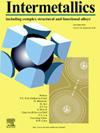低含ta铸态Ti-48Al-3Nb-1.5Ta合金蠕变行为及显微组织性能
IF 4.3
2区 材料科学
Q2 CHEMISTRY, PHYSICAL
引用次数: 0
摘要
研究了铸态低ta含量Ti-48Al-3Nb-1.5Ta (at.%)细晶近片层(FGNL)合金在800 ~ 900℃、150 ~ 250 MPa条件下的蠕变行为和性能。应力指数和蠕变活化能分别为2.0和395 kJ mol−1。Ti-48Al-3Nb-1.5Ta合金表现出优异的抗蠕变性能,达到了先进TNM+和TNB合金的水平。这是由于Nb和Ta合金的高温强化作用,抑制了扩散依赖性蠕变,降低了层错能,抑制了位错爬升。在蠕变条件下,Ta合金将脆性-韧性转变温度(BDTT)提高到~ 850℃。此外,Ti-48Al-3Nb-1.5Ta合金表现出良好的组织稳定性,在长时间蠕变暴露过程中没有检测到β(βo)和ω/τ相的析出。与Nb合金相比,Ta合金具有更好的高温强化效果和更低的ω/τ相形成倾向。用Ta取代部分Nb可以提高组织稳定性,同时保持现有TiAl-Nb合金在800-900℃时的抗蠕变性能。本文章由计算机程序翻译,如有差异,请以英文原文为准。
Creep behavior and microstructural properties of a cast low-Ta-containing Ti-48Al-3Nb-1.5Ta alloy
This study investigated the creep behaviors and properties of a cast low-Ta-containing Ti-48Al-3Nb-1.5Ta (at.%) alloy with fine-grained nearly-lamellar (FGNL) microstructure in the condition of 800∼900 °C and 150–250 MPa. The stress exponent and creep activation energy were 2.0 and 395 kJ mol−1, respectively. The Ti-48Al-3Nb-1.5Ta alloy exhibited superior creep resistance, reaching the level of advanced TNM+ and TNB alloys. It was attributed to the high-temperature strengthening effect of Nb and Ta alloying, which impeded diffusion-dependent creep and reduced the stacking fault energy to suppress dislocation climb. Ta alloying elevated the brittle-ductile transition temperature (BDTT) to ∼850 °C under creep conditions. In addition, the Ti-48Al-3Nb-1.5Ta alloy showed good microstructural stability with no detectable precipitation of β(βo) and ω/τ phases during prolonged creep exposure. Compared to Nb, Ta alloying had a better high-temperature strengthening effect and a lower tendency to form ω/τ phases. Replacing some Nb with Ta can improve the microstructure stability while maintaining the creep resistance of the current TiAl-Nb alloy at 800–900 °C.
求助全文
通过发布文献求助,成功后即可免费获取论文全文。
去求助
来源期刊

Intermetallics
工程技术-材料科学:综合
CiteScore
7.80
自引率
9.10%
发文量
291
审稿时长
37 days
期刊介绍:
This journal is a platform for publishing innovative research and overviews for advancing our understanding of the structure, property, and functionality of complex metallic alloys, including intermetallics, metallic glasses, and high entropy alloys.
The journal reports the science and engineering of metallic materials in the following aspects:
Theories and experiments which address the relationship between property and structure in all length scales.
Physical modeling and numerical simulations which provide a comprehensive understanding of experimental observations.
Stimulated methodologies to characterize the structure and chemistry of materials that correlate the properties.
Technological applications resulting from the understanding of property-structure relationship in materials.
Novel and cutting-edge results warranting rapid communication.
The journal also publishes special issues on selected topics and overviews by invitation only.
 求助内容:
求助内容: 应助结果提醒方式:
应助结果提醒方式:


